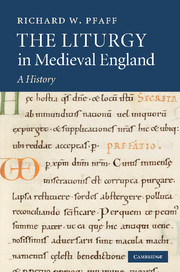Book contents
- Frontmatter
- Contents
- Preface
- Sigla and editorial conventions
- Bibliographical abbreviations
- Nicknames for manuscripts frequently referred to
- 1 Introduction
- Excursus: on sources
- 2 Early Anglo-Saxon England: a partly traceable story
- Excursus: on the terms Gregorian and Gelasian as used here
- 3 Later Anglo-Saxon: liturgy for England
- 4 The Norman Conquest: cross fertilizations
- Excursus: on method in the comparison of liturgical texts
- 5 Monastic liturgy, 1100–1215
- Excursus: on ascription of liturgical books to specific churches
- 6 Benedictine liturgy after 1215
- 7 Other monastic orders
- 8 The non-monastic religious orders: canons regular
- 9 The non-monastic religious orders: friars
- Excursus: on liturgical books from female religious houses
- 10 Old Sarum: the beginnings of Sarum Use
- 11 New Sarum and the spread of Sarum Use
- 12 Exeter: the fullness of secular liturgy
- 13 Southern England: final Sarum Use
- 14 Regional Uses and local variety
- 15 Towards the end of the story
- Index of Manuscripts
- Index of Saints
- General Index
7 - Other monastic orders
Published online by Cambridge University Press: 20 March 2010
- Frontmatter
- Contents
- Preface
- Sigla and editorial conventions
- Bibliographical abbreviations
- Nicknames for manuscripts frequently referred to
- 1 Introduction
- Excursus: on sources
- 2 Early Anglo-Saxon England: a partly traceable story
- Excursus: on the terms Gregorian and Gelasian as used here
- 3 Later Anglo-Saxon: liturgy for England
- 4 The Norman Conquest: cross fertilizations
- Excursus: on method in the comparison of liturgical texts
- 5 Monastic liturgy, 1100–1215
- Excursus: on ascription of liturgical books to specific churches
- 6 Benedictine liturgy after 1215
- 7 Other monastic orders
- 8 The non-monastic religious orders: canons regular
- 9 The non-monastic religious orders: friars
- Excursus: on liturgical books from female religious houses
- 10 Old Sarum: the beginnings of Sarum Use
- 11 New Sarum and the spread of Sarum Use
- 12 Exeter: the fullness of secular liturgy
- 13 Southern England: final Sarum Use
- 14 Regional Uses and local variety
- 15 Towards the end of the story
- Index of Manuscripts
- Index of Saints
- General Index
Summary
Cluniacs
There is a marked disconnect between the period during which the ten or so important Cluniac foundations in England were established and dates of the seven manuscript sources from which we might hope to get some idea as to their corporate worship. In one sense this should not trouble us much; patterns laid down in the customaries of the great age of Cluny itself, the abbacies of Odilo 994–1049 and Hugh 1049–1109, were meant to be normative in all the houses connected to it. In another, however, it is troubling that for the expression of Benedictine monasticism most celebrated for elaborate liturgical practice – the reputation, largely deserved, of the Cluniacs – we draw a blank among English sources until at least the third quarter of the thirteenth century.
The earliest of the ten English houses referred to above was Lewes, 1077, the latest Bro(o)mholm, 1113; the others are Much Wenlock, Castle Acre, Bermondsey, Montacute, Pontefract, Northampton, Lenton, and Thetford. The most extensive ruins are those at Acre, Wenlock, and Lewes. One liturgical book survives each from Lewes and Wenlock, none from Acre. For Pontefract both a breviary and a missal are extant, though of widely different dates. The remaining witnesses are scattered in type, date, and place of origin. The two we consider first are of a type not previously discussed.
Breviary-missals: priors' books?
These, the oldest books to be noticed, are a pair of combined breviary-missals, both rather splendid and probably designed for the use of a prior. The first was written, mostly in the third quarter of the thirteenth century, for Lewes.
- Type
- Chapter
- Information
- The Liturgy in Medieval EnglandA History, pp. 243 - 271Publisher: Cambridge University PressPrint publication year: 2009

